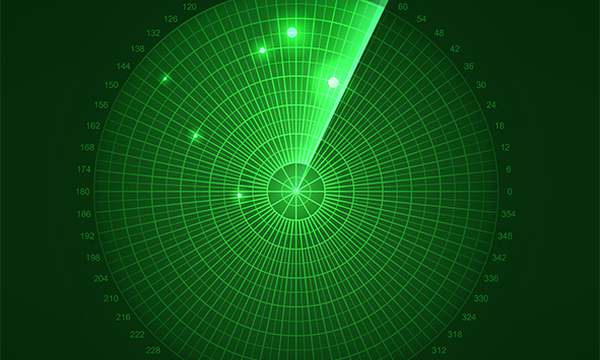
Radar Love
This article is from the CW Journal archive.
In 2010, the US Air Force’s deputy chief of staff for intelligence Lt Gen David Deptula said, “We’re going to find ourselves, in the not too distant future, swimming in sensors and drowning in data”. Since then, the flood of data has accelerated as greater volumes of data from an increasing number of sensors have been generated every day. While this began as a military problem, it is now also true in the civilian context as well. A common approach for dealing with this data deluge is through big data analytics where vast quantities of raw data are streamed to a central server which applies significant computational power to extract useful information.
An alternative approach allows the processing power to be moved closer to the raw data – ideally onto the sensor itself. This concept is known as edge analytics and it potentially reduces the volume of raw data that needs to be transmitted and stored centrally. This can be of particular benefit in real-time applications or those which require low-latency.
Edge analytics can be thought of as a form of compression whereby raw data measurements are converted into information locally, discarding noise and clutter. This can be seen in camera-based systems that perform facial recognition or automatic vehicle number plate recognition, for example. The raw data is the image, consisting of a spatial grid of light intensity values, which can be processed to extract a single unique identifier for a person or vehicle. Performing this recognition processing in a ‘smart camera’ with embedded processing would offer advantages over a standard camera which would need to transmit the full image across a network to a central server for subsequent processing.
This can also be applied to other sensing technologies, especially radar. Radars are well known to be able to detect objects and measure their position (by angle and range) and speed (via Doppler shift). This has historically been used for the detection and tracking of airborne objects for air traffic control, air defence or, more topically, for the detection of drones near airports. It is also possible to use these systems for other purposes such as in autonomous cars or for traffic monitoring and building automation. To achieve these goals, it is necessary to process the radar’s raw data to extract useful information.
|
GET CW JOURNAL ARTICLES STRAIGHT TO YOUR INBOX Subscribe now |

Unlike a camera, a radar system is an active sensor which relies on emitting specific radio frequency waveforms and then measuring the complex amplitude of the reflected echoes. Some degree of processing is therefore required to interpret the measurements in order to display the information as an image for empirical inspection. While there are various types of radar, a common approach for relatively small and inexpensive sensors is a frequency modulated continuous wave (FMCW) radar operating at GHz frequencies.
USING FOURIER TRANSFORMS TO CONVERT DATA IS A SIMPLE EXAMPLE OF EDGE ANALYTICS
As the name suggests, FMCW radar effectively transmits continuously but, unlike simple unmodulated continuous-wave systems, the transmission frequency is modulated over time. A common modulation scheme is a sawtooth pattern, such that the radar effectively emits a series of chirps that each comprise a linearly-increasing frequency sweep. The measured echoes will therefore contain the same frequency sweep but shifted in time due to the time-of-flight delay. As shown in Figure 1, comparing the measured echo from one chirp with the currently transmitted waveform (from the same chirp) against a specific time delay results in a constant frequency offset. Since the time delay is proportional to range, a Fourier transform of the measured samples within a chirp can produce a range profile showing signal amplitude versus range.
Similarly, by performing a second Fourier transform for each ‘range bin’ across a series of chirps (known as a frame), it is possible to measure the radial velocity components for that range. This produces a standard range-Doppler response ‘image’ for an FMCW radar system, which consists of a grid of measurements covering every combination of range and velocity bins.
A further enhancement to this system is to use multiple-input and multiple-output (MIMO) techniques and produce range-Doppler images for every pair of transmit and receive antennas. Since each antenna pair views the scene from a slightly different position, it allows the angle to an object to be calculated via digital beamforming. While various algorithms exist to achieve this, one approach is to implement a third Fourier transform across the same range-Doppler bin for all antenna pairs.
In radar, the raw data for a single frame can be represented as a cube. The first dimension represents the samples per chirp, the second dimension represents the number of chirps within a frame, and the final dimension is the number of transmit/receive antenna pairs. Embedded processing capability can be included in the radar to convert this cube into an alternative form with dimensions representing range, velocity and angle – however, this is only a data transformation and does not reduce the data volume.
The basic FMCW MIMO radar processing chain using Fourier transforms to convert the data into a more useful form is a simple example of edge analytics – though it does not necessarily have to be performed at the edge. However, the useful information is still buried within clutter and noise and therefore further analysis could be performed, as shown in Figure 2.
Since the range-Doppler image is typically sparse, the first step in extracting information is to use a detector to identify those range-Doppler bins that contain more than just noise or clutter. In this way, for example, a full radar cube containing 256 range bins, 128 velocity bins and eight antennas, could be reduced to a point cloud where each point has an associated range, velocity and angle value. This represents a significant data compression through the extraction of useful information and avoids the transmission and storage of data from range-Doppler bins that do not correspond to anything important in the observed scene.
While this detection step alone would represent a significant improvement gained from edge analytics, it is possible to improve things further. Since radar with very good range and velocity resolutions can be produced, it is possible that multiple points within the point cloud belong to the same object. Using a clustering algorithm, multiple points can be associated with each other as a single object. Furthermore, by analysing data from multiple frames over time it is also possible to track each object and confirm a continuous identity over time.
At this stage each object can be identified uniquely but the identity of the objects is not yet known. It would be useful to perform a classification step to differentiate between different types of objects, such as ‘pedestrians’ or ‘vehicles’. By analysing the detected points associated with a specific track identifier over time it may be possible to assign the object to a specific object class.
The result of this process is that, rather than the radar producing a stream of raw data at perhaps 100 Mbps, a lower but more useful bandwidth stream of unique tracked objects and associated metadata is produced. This allows self-contained smart devices using edge analytics to be an information producer rather than a data producer.

Traditionally, this processing chain is performed very close to the radar for many reasons. Transmitting the large raw data volumes was infeasible and, especially for air defence purposes, may have introduced an unacceptable latency in the system. Also, due to the military heritage of radar systems, security concerns would prevent the general use of cloud processing. However, the output tracks were often integrated into a network system. This is, again, especially true for air defence or air traffic control systems which may integrate track data from multiple sources to provide situational awareness across a large geographic area – an ideal example of the benefits of edge analytics.
Since many radars already include embedded processors to perform the Fourier transforms necessary to calculate range, velocity and angle, it is not uncommon for the detection step to be included as well. For example, AptCore produce a digital signal processor (DSP) core for radar processing that also performs detection. Although rarely referred to as such, this is edge analytics because it enables a point cloud of discrete radar echoes to be generated.
It is also possible to integrate additional processing into the sensor design to enable even greater analytical capability on a single device when converting point detections into discrete tracked objects. There are numerous suitable radar transceiver chips available from various suppliers, such as Infineon or NXP, that could be used to produce a smarter radar through the addition of an analogue-to-digital converter (ADC) to transform the data, an FPGA to perform the fast Fourier transforms (FFTs), and an Arm processor to execute the more advanced algorithms.
|
DO YOU HAVE A VIEW ON THIS SUBJECT, OR RESPONSE YOU'D LIKE TO SHARE? |
More recently, Texas Instruments has produced a family of single-chip mm-wave radars which are ideal for creating smart devices (Figure 3). These incorporate the multi-channel radar transceivers, ADC, DSP and Arm processor all on a single relatively inexpensive chip. For example, the IWR6843 chip has three transmitters and four receivers, operates from 60 GHz to 64 GHz and has both an integrated DSP and Arm processor. It is designed to directly output object tracks over a much lower bandwidth connection than that required for the raw data.
A smart radar has significant flexibility in the type of applications it can address. Though it is necessary to optimise the antenna design for a specific application, some performance changes can be achieved in software. For example, using a wider frequency bandwidth for each chirp improves the radar range resolution. Similarly, increasing the duration of a single frame of chirps allows the velocity resolution to be improved, providing additional discrimination between multiple objects.
The traditional application for radar is the detection of moving objects at long range, which is highly relevant for automotive applications. Such sensors are becoming more common for use in Advanced Driver-Assistance System (ADAS) and other collision-avoidance systems. Edge analytics in a radar system can be used for traffic or pedestrian monitoring as part of an intelligent transport system or other smart city networks. The same approach could be used for applications involving safety inside buildings by, for example, triggering an alert when a person is in an unsafe area, automated controls to turn lights off when no one is present, or for security to detect intruders.
While traditional radar transceivers could be used for this, products have become available which have been developed over the past few years for such alternative applications. For example, Novelda produce the Xethru range of sensors which have been designed as a presence and occupancy sensor within buildings. They are also capable of measuring respiration and heart rates for medical applications and, due to their lower frequency of operation, can see through walls, doors and other opaque surfaces. Similarly, the multi-channel Walabot range of MIMO radars from Vayyar have been designed for a range of non-traditional applications, such as seeing what’s inside a wall for DIY purposes, or fall-detection for the elderly. Such applications require local processing to realise their full benefits.
Another example of such systems is the smart road infrastructure radars developed by Plextek for Cranfield University’s Multi-User Environment for Autonomous Vehicle Innovation (MUEAVI). This radar is designed to monitor the position and velocity of autonomous vehicles within a controlled test environment. Raw data from this radar is transmitted at approximately 1 Gbps which has produced significant bandwidth and storage challenges. By performing edge analytics on this data stream to remove noise and weak clutter, it was possible to only transmit information regarding objects of interest which reduced the required bandwidth to a significantly more manageable 1 Mbps instead.
A further advantage of edge analytics for radar is that adding processing power close to the sensor enables the processed output of previous frames to change the transmitted waveform dynamically. This would not be possible if a remote server processed the signal because of response delays due to higher latency. Edge processing means a radar could be set to detect at a high maximum range and then optimise its parameters for a shorter range if no distant objects were sensed. Alternatively, it could shift its operational frequency to avoid conflict with other emitters in the same region, actively avoiding undesirable interference.
This concept is known as cognitive radar and it aims to close the loop between the transmitter, the environment and the receiver to produce a dynamic closed-feedback loop (Figure 4). Feedback loops that enable interaction with the environment are key elements of human cognition, and it is no coincidence that equivalents to radar in the natural world, such as sonar used by bats and toothed whales, are also dynamically modified in response to the environment.
For these reasons, the incorporation of radar in smart devices using edge analytics to produce actionable information is an interesting growth area for the future. Single-chip radars are likely to become more widespread as they appear in a wide range of applications to provide dynamic sensing capabilities.
|
GET INVOLVED WITH THE CW JOURNAL & OTHER CW ACTIVITIES |
Dr Damien Clarke holds an MSci in Natural Sciences from the University of Cambridge and a PhD in Physics from the University of Surrey. He previously worked at the Defence Science Technology Laboratory (Dstl) in remote sensing and now acts as a technical authority for many of Plextek’s communications projects, taking responsible for delivering technical solutions in sensor systems and machine learning.











